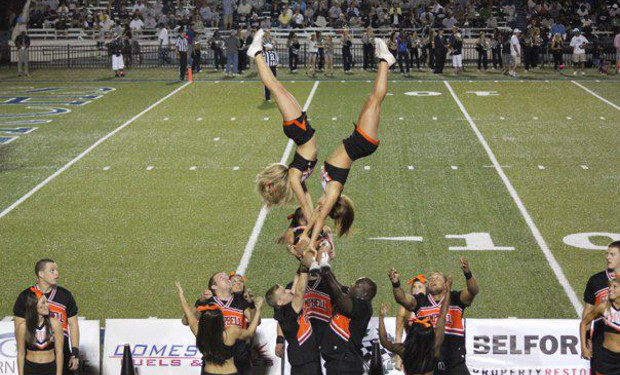Cheerleading Is Not a Sport (for Now at Least)
According to the Court of Appeals for the Second Circuit, competitive cheerleading cannot be considered a varsity sport for purposes of complying with Title IX of the Education Amendments of 1972 (Title IX). Title IX was enacted to afford men and women equal opportunities in education and sports.
The ruling comes from an appeal by Quinnipiac University in Hamden, Connecticut (Quinnipiac), who argued that competitive cheerleading should be counted as a varsity sport for Title IX purposes. In 2009, the university announced it would eliminate its varsity sports teams for women’s volleyball, men’s golf, and men’s outdoor track and field, while creating a new varsity sports team for women’s competitive cheerleading. This change prompted several women volleyball players and their coach to file suit in federal district court seeking to enjoin the university from eliminating women’s volleyball in favor of competitive cheerleading.
Under Title IX, universities must provide opportunities to both male and female students that are “substantially proportionate to their respective enrollments.” At trial, the university demonstrated 5,686 students were enrolled in its undergraduate program for the 2009 to 2010 academic year—3,518 of which were female while 2,168 were male. That year, the school also reported 440 varsity athletes, comprising of 274 female and 166 male athletes. Thus, Quinnipiac maintained that women comprised 61.87 percent of the student body and 62.27 percent of the university’s varsity athletes. Quinnipiac also maintained that their male counterparts comprised 38.13 percent of the student body and 37.73 percent of the university’s varsity athletes. The percentages, the university argued, were “substantially proportionate.”
The district court, however, did not accept Quinnipiac’s reported numbers, in electing not to consider the thirty competitive cheerleading roster spots in the athlete count for Title IX purposes. After the district court’s findings and calculations, the new disparity between total women enrolled and women varsity athletes was 3.62 percent, which the district court found to be a “borderline case of disproportionate athletic opportunities for women.”
The district court concluded this disparity was significant enough to support a judgment in favor of the plaintiffs for two reasons: (1) the disparity was caused by Quinnipiac’s own actions and not by fluctuations of enrollment and (2) it was reasonable for the university to close the rather small gap with the women’s volleyball team, which was already in existence. As such, the district court ordered the university to keep its women’s volleyball team.
The district court’s holding that competitive cheerleading is not a “sport” and its subsequent exclusion of Quinnipiac’s 30 competitive cheerleading roster spots was of particular importance, as it had an obvious effect on the disparity of total enrollment and athletes. Before holding competitive cheerleading is not a “sport,” the court recognized that competitive cheerleading is fundamentally different than traditional “sideline” cheerleading, stating competitive cheerleading “can be physically challenging, requiring competitors to possess ‘strength, ability, and grace.’”
Despite the athletic ability required for competitive cheerleading and its additional qualities similar to that of other varsity sports, the court noted several distinct differences between common varsity sports and competitive cheerleading, such as the lack of off-campus recruitment, no uniform set of rules at cheerleading competitions, and competitions against non-collegiate teams. The court noted two “touchstones” of varsity sports are a uniform set of rules and the restriction of competition to other collegiate varsity programs. The district court and the court of appeals also emphasized that competitive cheerleading holds no progressive playoff system leading to a championship game. Both courts concluded that competitive cheerleading is not a “sport” for purposes of Title IX. Although the court of appeals did not find competitive cheerleading to be a “sport,” it did not “foreclose the possibility that the activity, with better organization and defined rules, might some day warrant recognition as a varsity sport.”
Jonathan Orleans who represented the plaintiffs said, “This is a great victory for Quinnipiac’s female student athletes and for women’s collegiate sports.” Quinnipiac spokeswoman Lynn Bushnell released a statement in which she commented, “The university naturally is disappointed that the court did not rule as it had hoped . . . Quinnipiac will continue to enhance opportunities for our female student-athletes, which include volleyball, acrobatics and tumbling, basketball, cross country, field hockey, golf, ice hockey, lacrosse, rugby, soccer, softball, tennis and indoor and outdoor track and field.” Bushnell did not indicate whether the university planned to file a petition for writ of certiorari to the Supreme Court.
Quinnipiac has since renamed its competitive cheerleading program to “acrobatics & tumbling,” and has joined the National Collegiate Acrobatics and Tumbling Association (NCATA). The NCATA was formed in part to distance competitive cheerleading from traditional sideline cheerleading, in hopes of gaining official recognition as a sport. The executive director of NCATA, John Blake, believes acrobatics and tumbling will one day obtain federal recognition, and said, “We’ve done both what the judge asked us to do and what the NCAA has asked us to do, and we’ve been in communication with the Department of Education.”
It is unclear whether competitive cheerleading or acrobatics and tumbling will ever gain federal recognition as a varsity sport. While it may not currently be counted as a varsity sport for Title IX purposes, it appears as though competitive cheerleading officials are taking steps in the right direction to gain recognition.

